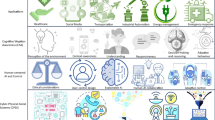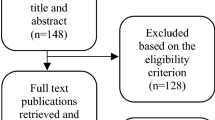Abstract
This paper will be both to give an in-depth analysis as well as to present the new material on the notion of context-aware computing, an idea that computing can both sense and react accordantly based on its environment. The paper formalizes context-awareness process using coalgebraic language, including the coalgebraic definition of context-awareness, bisimulation between context-awarenesses, homomorphism between context-awarenesses and context-awarenesses as coalgebras. Discussions for further development based on this approach are also given.

Similar content being viewed by others
Notes
The NTTU foundation for Science and Technology Development.
References
Barbosa LS (2000) Components as processes: an exercise in coalgebraic modeling. In: Smith SF, Talcott CL (eds) 4th international conference on formal methods for open object-based distributed systems, IFIP TC6/WG6.1, 6–8 September 2000. Kluwer Academic Publishers, Stanford, CA, USA, pp 397–417
Barbosa LS, Liu Z (eds) (2005) Proceedings of the 2nd international workshop on formal aspects of component software (FACS), Macao, 24–25 October 2005. UNU/IIST. ENTCS
Cockett R, Spencer D (1991) Strong categorical datatypes I. In: Seely RAG (ed) International summer meeting on category theory, AMS Canadian Mathematical Society, 23–30 June 1991. AMS, Montréal, Québec, Canada, pp 141–169
Hagino T (1987) A typed lambda calculus with categorical type constructors. In: Pitt DH, Poigné A, Rydeheard DE (eds) Category theory and computer science, September 1987. Lecture notes in computer science, vol 283. Springer–Verlag, Edinburgh, UK, pp 140–157
Jacobs B, Rutten J (1997) A tutorial on (Co)Algebras and (Co)Induction. Bulletin of EATCS 62:222–259
Kiczales G, Lamping J, Menhdhekar A, Maeda C, Lopes C, Loingtier JM, Irwin J (1997) Aspect-oriented programming. In: Akşit M, Matsuoka S (eds) 11th European conference on object-oriented programming (ECOOP), 10 June 1997. Lecture notes in computer science, vol 1241. The paper originating AOP, Springer–Verlag, Jyväskylä, Finland, pp 220–242
Kieburtz RB (1998) Reactive functional programming. In: Gries D, Roever WPde (eds) Programming concepts and methods (PROCOMET), IFIP international federation for information processing, 8–12 June 1998. Chapman and Hall, Shelter Island, NY, USA, pp 263–284
Levine M (1998) Categorical algebra. In: Benkart G, Ratiu TS, Masur HA, Renardy M (eds) Mixed motives, mathematical surveys and monographs, vol 57, chapter I, II, II of part II, American Mathematical Society, USA, pp 373–499
Meijer E, Fokkinga M, Paterson R (1991) Functional programming with bananas, lenses, envelopes and barbed wire. In: Hughes J (ed) ACM conference on functional programming languages and computer architecture, 26–30 August 1991. Lecture notes in computer science, vol 523. Springer–Verlag, Cambridge, MA, USA, pp 124–144
Rotman JJ (2002) Advanced modern algebra, 1st edn. Prentice Hall, USA
Rutten JJMM (1998) Automata and coinduction (an exercise in coalgebra). In: 9th international conference on concurrency theory (CONCUR), 8–11 September 1998. Lecture notes in computer science, vol 1466. Springer–Verlag, Nice, France, pp 194–218
Rutten JJMM (2000) Universal coalgebra: a theory of systems. Theor Comp Sci 249(1):3–80
Rutten JJMM (2001) Elements of stream calculus (an extensive exercise in coinduction). In: Proceedings of the 17th annual conference on mathematical foundations of programming semantics (MFPS ’01), Aarhus, Denmark, ENTCS, vol 45. Elsevier Science B.V., 66 p
Rutten JJMM (2005) Algebra, bitstreams, and circuits. Technical Report SEN-R0502, CWI, Amsterdam, The Netherlands
van Oosten J (2002) Basic category theory. Department of Mathematics, Utrecht University, The Netherlands
Vinh PC (2009) Autonomic computing and networking, chapter formal aspects of self-* in autonomic networked computing systems. Springer, pp 381–410
Vinh PC (2009) Dynamic reconfigurability in reconfigurable computing systems: formal aspects of computing, 1st edn. VDM Verlag, 236 p
Vinh PC (2011) Formal and practical aspects of autonomic computing and networking: specification, development, and verification, chapter formal specification and verification of self-configuring p2p networking: a case study in mobile environments, 1st edn. IGI Global, pp 170–188
Vinh PC (2012) Data intensive distributed computing in data aware self-organizing networks. In: Transactions on computational science XV: special issue on advances in autonomic computing: formal engineering methods for nature-inspired computing systems. Springer, Berlin, pp 74–107
Acknowledgements
Thank you to NTTUFSTDFootnote 1 for the constant support of our work which culminated in the publication of this paper. As always, we are deeply indebted to the anonymous reviewers for their helpful comments and valuable suggestions which have contributed to the final preparation of the paper.
Author information
Authors and Affiliations
Corresponding author
Rights and permissions
About this article
Cite this article
Cong Vinh, P., Thanh Tung, N. Coalgebraic Aspects of Context-Awareness. Mobile Netw Appl 18, 391–397 (2013). https://doi.org/10.1007/s11036-012-0404-0
Published:
Issue Date:
DOI: https://doi.org/10.1007/s11036-012-0404-0




